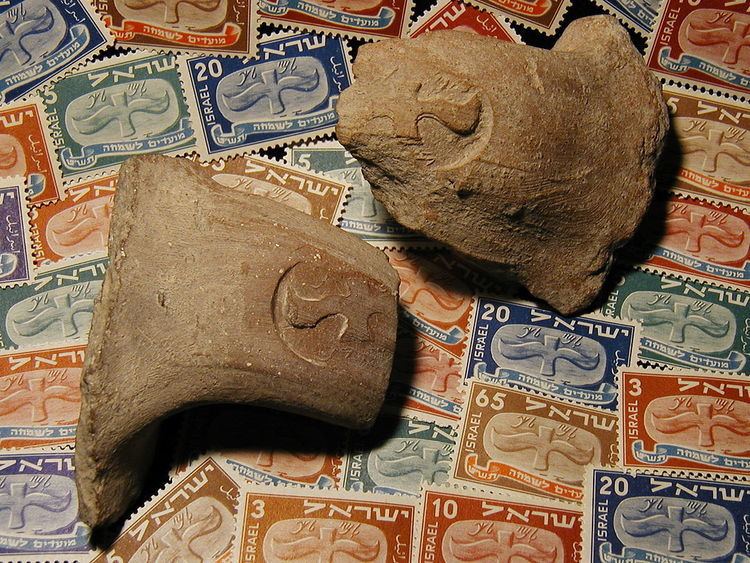 | ||
LMLK seals are ancient Hebrew seals stamped on the handles of large storage jars dating from reign of King Hezekiah (circa 700 BC) discovered mostly in and around Jerusalem. Several complete jars were found in situ buried under a destruction layer caused by Sennacherib at Lachish. While none of the original seals have been found, some 2,000 impressions made by at least 21 seal types have been published.
Contents
למלך
LMLK stands for the Hebrew letters lamedh mem lamedh kaph (vocalized, lamelekh), which can be translated as:
As a prepositional prefix, the lamedh (ל) has either a genitive or dative function, and the "to" in each of the above readings can also be read as "for" or "of". The other three letters form the word "melech"; as shown above, its translation can refer to a specific king, to any king, or to the king's government.
Sites
Though most of these stamped jar handles have been found in the southern kingdom (71 sites in the ancient territory assigned to the tribes of Judah, Benjamin, and Simeon), some have also been found in the northern kingdom (4 sites in the northwest region). Here is an abbreviated list of the top 20 sites where most specimens have been found through scientific excavations:
Theories
Beginning with the editio princeps by Charles Warren in 1870, a diverse assortment of theories has been promulgated to explain their function. Since the landmark excavations at Lachish by David Ussishkin during the 1970s, which established the date of the seals to the reign of Hezekiah, the number of feasible explanations has narrowed down to these (all associated with Hezekiah ):
In support of the first two theories are the inscriptions, which can be read as the names of four places; in support of the third theory are the geographic statistics, which do not associate any of the four words to a particular place or region other than the entire southern kingdom of Judah. Furthermore, approximately 10–20 percent of the excavated jars and jar handles were stamped.
Depending on which of the above theories are preferred, several other aspects of the operation need interpretation:
Engraving styles indicate at least two, possibly five, people made the seals. The 21 types can be grouped together in five or six sets, but they may have been created or utilized in pairs based on quantities of their impressions found so far and internal evidence such as inconsistent use of divider dots.
Researchers frequently use a lowercase "x" as a wildcard character when referring to a series such as x4C instead of using an uppercase "G", "H", "M", "S", or "Z" for the first letter designator. Likewise, an "x" can be used for the second letter designator when referring to all seals with the same word, such as H2x in lieu of H2D, H2T, and H2U.
Thus far, significant quantities of x4C, x4L, and x2U stamps have been excavated from below the destruction layer caused by the Assyrian conquest of Sennacherib, but only a single specimen each of the G2T and M2D stamps (excavated from Jerusalem, which was not destroyed by Sennacherib). This suggests that 12 of the 21 seals were made prior to the attack, and the remaining 9 afterwards. The first significant evidence to support this datum came from the landmark excavations at Timnah led by George L. Kelm and Amihai Mazar.
Personal seals
Several hundred seal impressions made on the same type of jar handle have been found in the same contexts as the LMLK stamps. Over 50 types have been documented, and most of them have a 2-line inscription divided by two somewhat parallel lines. Some have an icon in addition to the inscription; others are strictly anepigraphic (Vaughn 1999).
Incisions
In addition to the seals, which were stamped in the wet clay before being fired in a kiln, certain other marks were incised on these jar handles:
Hundreds of the Circles have been found, but only a few of the Plus, Hole, and Drag marks. Several LMLK stamps may have had additional inscriptions incised over them containing marks resembling the letters "I V" (hence "Ivy incisions"); however, one or more of these handles may just contain stray Drag marks resembling the letters "I V" with no literate semantics intended.
Israeli postage
In 1948, Israel's postal authority chose the Z2U seal design for the first series of postage stamps to include the name of the renascent state. Five multicolored values (3, 5, 10, 20, and 65-mil denominations; Scott catalog numbers 10-4) were printed in sheets of 300 (six panes of 50). Otte Wallish designed the stamps, which have distinctive tabs written in Hebrew declaring: Flying Scroll: "LMLK" Seal Stamped on the Wine and Oil Jugs Given as Tax to the King. Israel released the stamps on September 26, 1948 in time for the October 4 observance of Rosh Hashanah 5709, the Jewish New Year, and thereby inaugurated its annual series of holiday stamps.
Drawings
Types of LMLK seals:
